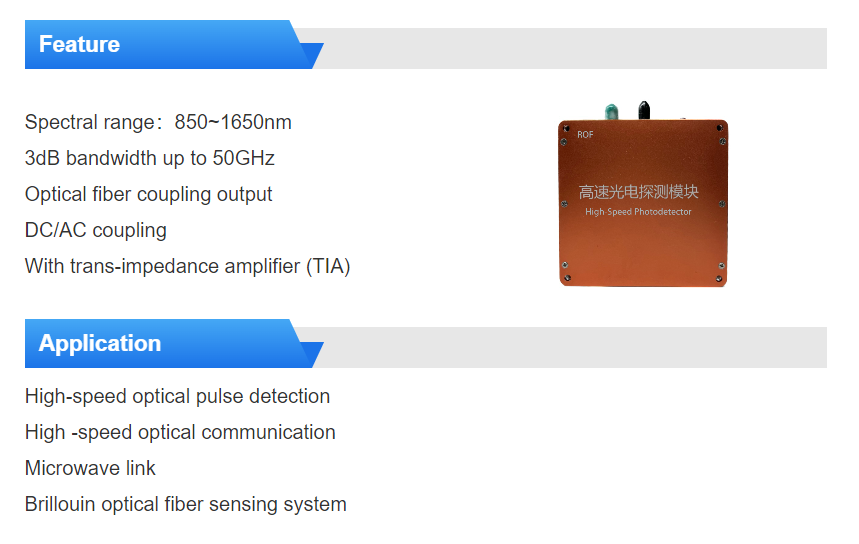Basic characteristic parameters of optical signal photodetectors:
Before examining various forms of photodetectors, the characteristic parameters of the operating performance of optical signal photodetectors are summarized. These characteristics include responsivity, spectral response, noise equivalent power (NEP), specific detectivity, and specific detectivity. D*), quantum efficiency, and response time.
1. responsivity Rd is used to characterize the response sensitivity of the device to optical radiation energy. It is represented by the ratio of output signal to incident signal. This characteristic does not reflect the noise characteristics of the device, but only the efficiency of converting electromagnetic radiation energy into current or voltage. Therefore, it may vary with the wavelength of the incident light signal. In addition, the power response characteristics are also a function of the applied bias and the ambient temperature.
2. The spectral response characteristic is a parameter that characterizes the relationship between the power response characteristic of the optical signal detector and the wavelength function of the incident optical signal. The spectral response characteristics of optical signal photodetectors at different wavelengths are usually described quantitatively by “spectral response curve”. It should be noted that only the highest spectral response characteristics in the curve are calibrated by absolute value, and the other spectral response characteristics at different wavelengths are expressed by normalized relative values based on the highest value of spectral response characteristics.
3. The noise equivalent power is the incident light signal power required when the output signal voltage generated by the optical signal detector is equal to the inherent noise voltage level of the device itself. It is the main factor that determines the minimum optical signal intensity that can be measured by the optical signal detector, that is, the detection sensitivity.
4. Specific detection sensitivity is a characteristic parameter that characterizes the inherent characteristics of the photosensitive material of the detector. It represents the lowest incident photon current density that can be measured by an optical signal detector. Its value can vary according to the operating conditions of the wavelength detector of the measured light signal (such as ambient temperature, applied bias, etc.). The larger the detector bandwidth, the larger the optical signal detector area, the smaller the noise equivalent power NEP, and the higher the specific detection sensitivity. The higher specific detection sensitivity of the detector means that it is suitable for the detection of much weaker optical signals.
5. Quantum efficiency Q is another important characteristic parameter of optical signal detector. It is defined as the ratio of the number of quantifiable “responses” produced by the photomon in the detector to the number of photons incident on the surface of the photosensitive material. For example, for light signal detectors operating on photon emission, quantum efficiency is the ratio of the number of photoelectrons emitted from the surface of the photosensitive material to the number of photons of the measured signal projected onto the surface. In an optical signal detector using p-n junction semiconductor material as photosensitive material, the quantum efficiency of the detector is calculated by dividing the number of electron hole pairs generated by the measured light signal by the number of incident signal photons. Another common representation of the quantum efficiency of an optical signal detector is by means of the detector’s responsivity Rd.
6. Response time is an important parameter to characterize the response speed of the optical signal detector to the intensity change of the measured light signal. When the measured light signal is modulated into the form of a light pulse, the intensity of the pulse electrical signal generated by its action on the detector needs to “rise” to the corresponding “peak” after a certain response time, and from the “peak” and then fall back to the initial “zero value” corresponding to the action of the light pulse. In order to describe the response of the detector to the intensity change of the measured light signal, the time when the intensity of the electrical signal generated by the incident light pulse rises from its highest value of 10% to 90% is called the “rise time”, and the time when the electrical signal pulse waveform falls from its highest value of 90% to 10% is called the “fall time” or “decay time”.
7. Response linearity is another important characteristic parameter that characterizes the functional relationship between the response of the optical signal detector and the intensity of the incident measured light signal. It requires the output of the optical signal detector to be proportional within a certain range of the intensity of the measured optical signal. It is usually defined that the percentage deviation from the input-output linearity within the specified range of the input optical signal intensity is the response linearity of the optical signal detector.
Post time: Aug-12-2024






